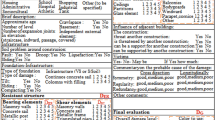Abstract
The preliminary development and final description of the engineering knowledge and reasoning pertaining to an expert system to assist during the field inspection of existing concrete gravity dams have been described in Refs. [1] and [2]. The purpose of this paper is to describe the artificial intelligence (AI) issues that were raised during the construction of the expert system. The first part of the paper deals with techniques used to identify the engineering knowledge, using heuristic classification and/or construction as in the expert system approach and causal and/or teleological reasoning as in the qualitative physics approach. The second part of the paper covers specific issues related to knowledge acquisition. The last part addresses various issues of knowledge representation as they are directly relevant to this expert system. Examples relative to AI concepts have been presented in Ref. [2].
Similar content being viewed by others
References
Franck, B. M.; Krauthammer, T. (1988) Development of an expert system for preliminary risk assessment of existing concrete dams. Eng. Comput. 3, 137–148.
Franck, B. M.; Krauthammer, T. (1989) An expert system for field inspection of concrete dams: Part 1, engineering knowledge. Eng. Comput. 5, 23–38
Blockley, D. (1987) Uncertain inference in knowledge-based systems, J. Eng. Mech. ASCE 113(4), 467–481
Davis, R.; Lenat, D. B. (1982) Knowledge-based systems in artificial intelligence. New York: McGraw-Hill
Newell, A. (1981) The knowledge level. AI Magazine 2(2), 1–20
Waterman, D.A. (1986) A guide to EXPERT SYSTEMS. Reading, PA: Addison-Wesley Publishing
De Kleer, J.; Brown, J.S. (1986) Theories of causal reasoning. AI J. 29, 33–61
Clancey, W.J. (1984) Classification problem solving. Report No. STAN-CS-84-1018, Stanford University, CA
Clancey, W.J. (1985) Heuristic classification. J AI 27(2), 289–350
Hayes-Roth, F.; Waterman, D.A.; Lenat, D.B. (1983) Building expert systems. In: The Teknowledge Series in Knowledge Engineering. Reading, PA: Addison-Wesley
Davis, R. (1984) Diagnostic reasoning based on structure and behavior. AI J. 24, 347–410
Blockley, D. (1980) The nature of structural design and safety, New York: John Wiley & Sons
Yao, J.T.P. (1985) Safety and reliability of existing structures. Pitman Publishing
De Kleer, J. (1984) How circuits work. AI J. 24, 205–280
Jansen, R.B.; Carlson, R.W.; Wilson, E.L. (1973) Diagnosis and treatment of dams. In: Transactions of the Madrid Congress sponsored by the International Commission Of Large Dams
Franck, B.M. (1987) Preliminary safety and risk assessment for existing hydraulic structures—An expert system approach. Ph.D. thesis, Graduate School, University of Minnesota
Freudenthal, A.M. (1947) The safety of structures. ASCE Trans. 112, 125–180
American Society of Civil Engineers, The Committee on the Failures and Accidents to Large Dams of the U.S. Committee on Large Dams. (1975) Lessons from dams incidents—USA. Published jointly by ASCE/USCOLD
American Society of Civil Engineers, Hydraulic Structures Committee of the Hydraulics Division. (1986) Lessons learned from design, construction, and performance of hydraulic structures
National Research Council, Safety of existing dams—Evaluation and improvement. (1983) Committee on the Safety of Existing Dams, Water Science and Technology Board, Commission on Engineering and Technology Systems, National Research Council, National Academy Press
Kahn, G.; Nowlan, S.; McDermott, J. (1985) Strategies for knowledge acquisition. IEEE Trans. Pattern Anal. Mach. Intel. PAMI-7(5), 511–522
Clancey, W.J. (1984) Knowledge acquisition for classification expert systems. In: Proceedings ACM 1984 Annual Conference: The Fifth Generation Challenge (Ed. R.L. Muller). Amsterdam: North-Holland, 11–14
Kuipers, B. (1984) Common sense reasoning about causality: Deriving behavior from structure. AI J. 24, 169–203
Johnson, P.E. (1984) The expert mind: A new challenge for the information scientist. In: BEYOND PRODUCTIVITY: Information Systems Development for Organizational Effectiveness (Ed. M.A. Bemelmans, New York: Elsevier Science Publishers, 367–386
Fink, P.K.; Lusth, J.C.; Duran, J.W. (1985) A general expert system design for diagnostic problem solving. IEEE Trans. Pattern Anal. Mach. Intel. PAMI-7(5), 553–560
Rich, E. (1983) Artificial intelligence. McGraw-Hill series on Artificial Intelligence. New York: McGraw-Hill
Texas Instruments Incorporated (1986) PERSONAL CONSULTANT PLUS, Version 2.1, Vols. 1 & 2
Author information
Authors and Affiliations
Rights and permissions
About this article
Cite this article
Franck, B.M., Krauthammer, T. An expert system for field inspection of concrete dams: Part 2, artificial intelligence issues. Engineering with Computers 5, 119–131 (1989). https://doi.org/10.1007/BF01199074
Issue Date:
DOI: https://doi.org/10.1007/BF01199074




